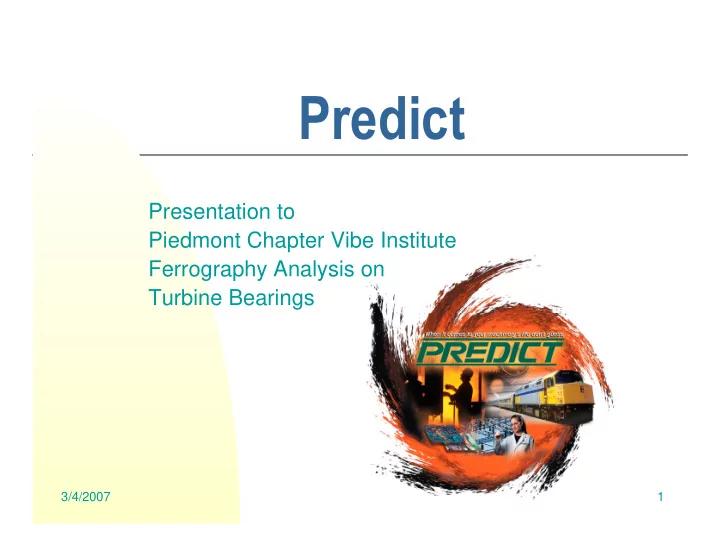

Predict Presentation to Piedmont Chapter Vibe Institute Ferrography Analysis on Turbine Bearings 3/4/2007 1
Topics of Discussion Who is Predict? Ferrography Application Wear Particles Questions and Answers 3/4/2007 2
Lab Service Products New & used lubricant & grease testing Hydraulic fluid testing Fuels testing Transformer oil testing Coolant testing Wear particle analysis (Ferrography) Supplies (pumps, oil taps, tubing, etc.) Training Program management 3/4/2007 3
Lab Analysis Reporting Equipment & Lube Condition 3/4/2007 4
Three Body Abrasive Wear Due to foreign particles in the oil. The harder dirt particle imbeds itself in a softer metal and gouges the metal away from the rotating metal separated by the lubricant film. Metal Component Lubricant Film Imbedded Particle Gouged Metal 3/4/2007 5
Three Body Abrasive Wear 3/4/2007 6
Two Body Abrasive Wear Due to a misalignment or an asperity of a harder metal component gouging the opposite rotating softer metal. Misaligned component Lubricant Film Gouged Metal 3/4/2007 7
Two Body Abrasive Wear 3/4/2007 8
3/4/2007 9
Air Compressor 3/4/2007 10
Gear Box 3/4/2007 11
Power Plant 3/4/2007 12
Turbine 3/4/2007 13
Bearing 3/4/2007 14
Bearing 3/4/2007 15
Small Bearings 3/4/2007 16
The Basics of Ferrographic Analysis
Wear Particle Analysis A Three Step Process 1. TRENDING Wear Particle Concentrations to Identify Onset of Abnormal Wear 2. PARTICLE IDENTIFICATION Microscopic & Analytical Analysis to Determine Origin & Severity 3. INTERPRETATION Analysis of All Data & Recommendations
Density Reading Ferrograph Quantitative Analysis DR Ferrograph
DR General Acceptance Limits WEAR PARTICLE CONCEN. ACCEPTANCE LIMITS Vacuum Pumps WPC = 1-5 Boiler Feed Pumps WPC = 1-100 Gas Compressors WPC = 1-20 Turbines Fans Journal Bearings WPC = 1-20 Roller Bearings WPC = 5-100 Engines WPC = 10-150 Transmissions Extruder Gearboxes WPC = 100-600 Dragline Gearboxes WPC = 1,000-50,000 Hoist Gearboxes
Wear Particle Analysis Instruments Qualitative Analysis FM Ferrograph
Wear Particle Analysis Testing Ferrogram Maker Distance in mm Non-Ferrous Flux Lines w/Debris Debris N Magnet Pole EXIT END Non-Magnetic Barrier, 2.5mm Non-Wetting S Magnet Pole Barrier 0.3x60mm Glass ENTRY POINT < 0.5mm Ferrous -5mm | +5mm Substrate Particles Ferrous Particles
Wear Particle Analysis Instruments Qualitative Analysis Qualitative Analysis Ferroscope V Ferroscope V
Wear Particle Analysis System & Software Passport System V
Particle Classifications NON-FERROUS - COPPER ALLOYS, ALUMINUM, BABBITTED METALS, ZINC, CHROME, ETC. FERROUS - MAGNETIC, PARAMAGNETIC; Fe, Fe 2 O 3 , Fe 3 O 4 ; STAINLESS CONTAMINANT - FLUIDS; DUST, DIRT, EXTERNAL PROCESS; MANUFACTURING DEBRIS; FILTER MATERIAL; FRICTION POLYMERS; ORGANIC MATTER
Types of Particles Red Oxides Normal Rubbing Wear Fe 2 O 3 Cutting Wear Fe 2 O 3 Bearing Wear Spheres Severe Sliding Wear Sand & Dirt Gear Wear Friction Polymers Nonferrous Wear Particles Contaminant Spheres Corrosive Wear Fibers Black Oxides Evidence of Water Contamination 3/4/2007 26
Normal Rubbing Wear Particles 3/4/2007 27
Cutting Wear Indicative of Misalignment or Presence of Abrasive Contaminants Long, Curly Strips of Material Aspect Ratios Ranging From 5:1 to 50:1 (Length to Width) Never Considered Normal
Cutting Wear Particles Copper Alloy Low Alloy Steel High Alloy Steel
Bearing Wear Rolling Fatigue Wear Flat Platelets With Perforated Surfaces and Irregular Edges
Bearing Wear Particles 3/4/2007 31
Severe Sliding Wear Excessive Speeds/Loads on Critical Contacts Within the Equipment Typically Rectangular Particles With Striations Parallel to the Direction of Elongation
Severe Sliding Wear Particles 3/4/2007 33
Gear Wear Combined Rolling and Sliding Wear Flat Platelets Fatigue Spall - Similar to Bearing Wear Debris Adhesive Wear - May have striations or other surface features Scuffing and Scoring - Similar to Severe Sliding Wear Debris
Gear Wear Particles 3/4/2007 35
Corrosive Wear Due to Acidic Attack on the Internal Surfaces of Equipment Small Particles <1 Micron in Size Align Themselves on the Outer Edges of a Ferrogram
Corrosive Wear 3/4/2007 37
Black Oxides Due to High Temperatures at Critical Contacts Within a Unit Black Particles Align in the Ferrous Strings Indicative of Boundary Lubrication Condition
Black Oxides
Spheres Spherical Particles Usually 5-10 Microns in Size Indicative of Bearing Fatigue Prior to a Spalling Condition Black Circles with Shiny Centers
Spheres 3/4/2007 41
Sand/Dirt Particles Contaminants Introduced Through Breather Elements, Seals, Cylinder Heads, Etc. Transparent, Translucent, or Opaque Crystalline or Birefringent Material Deposits Over the Length of the Slide Easily Seen Under Polarized Light
Sand and Dirt UNDER POLARIZED LIGHT
Sand/Dirt Under Polarized Light 3/4/2007 44
De Laval Steam Turbine 3/4/2007 45
Turbine Journal 3/4/2007 46
Turbine 3/4/2007 47
Courtesy of AISE 3/4/2007 48
Bearings Good/Bad 3/4/2007 49
Courtesy of AISE 3/4/2007 50
Turbine Bearings 3/4/2007 51
Courtesy of AISE 3/4/2007 52
Heat Treatment Procedures All slides should be heat treated if large or marginal particles are detected Monitor temperature of hot plate to ensure temperature of 330 o C, + or - 10 o C Maintain slide on hot plate for at least 90 seconds to ensure saturation of oxide layer growth
Low Alloy Steel Inclusion of small amounts of alloys Blue Color 3/4/2007 54
Cast Iron / Medium Alloy Steel @ 330C Inclusions on the surface Less area for ion formation • Less oxide growth
Journal Bearings 3/4/2007 56
Turbine Bearings 3/4/2007 57
Journal Bearings 3/4/2007 58
Bearings 3/4/2007 59
Spalled Bearing 3/4/2007 60
What Are The Benefits? Reduced Maintenance Costs Reduced Unscheduled Downtime Improved OEM Warranty Programs Adds Proactive Maintenance/Root Cause Analysis Capability Product Quality Improvements Improved Plant Safety
World Class Predictive Maintenance Solutions That Work That Work for YOU!!!! for YOU!!!!
Recommend
More recommend